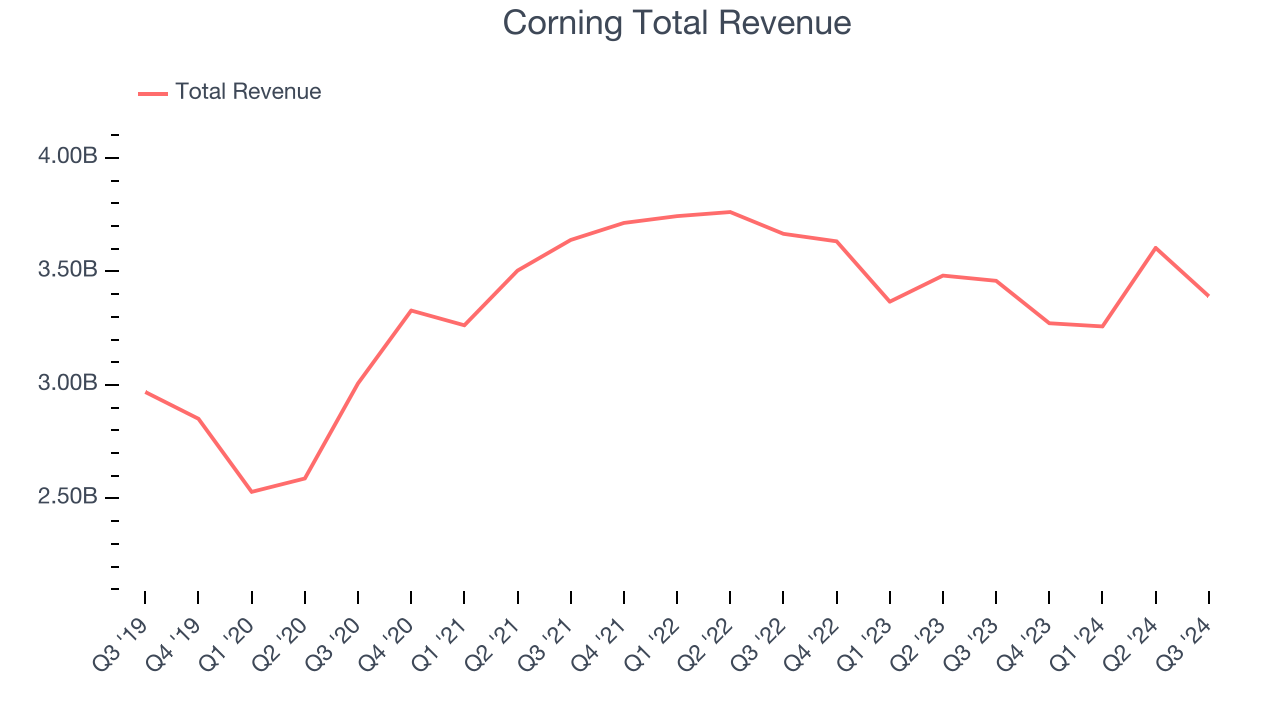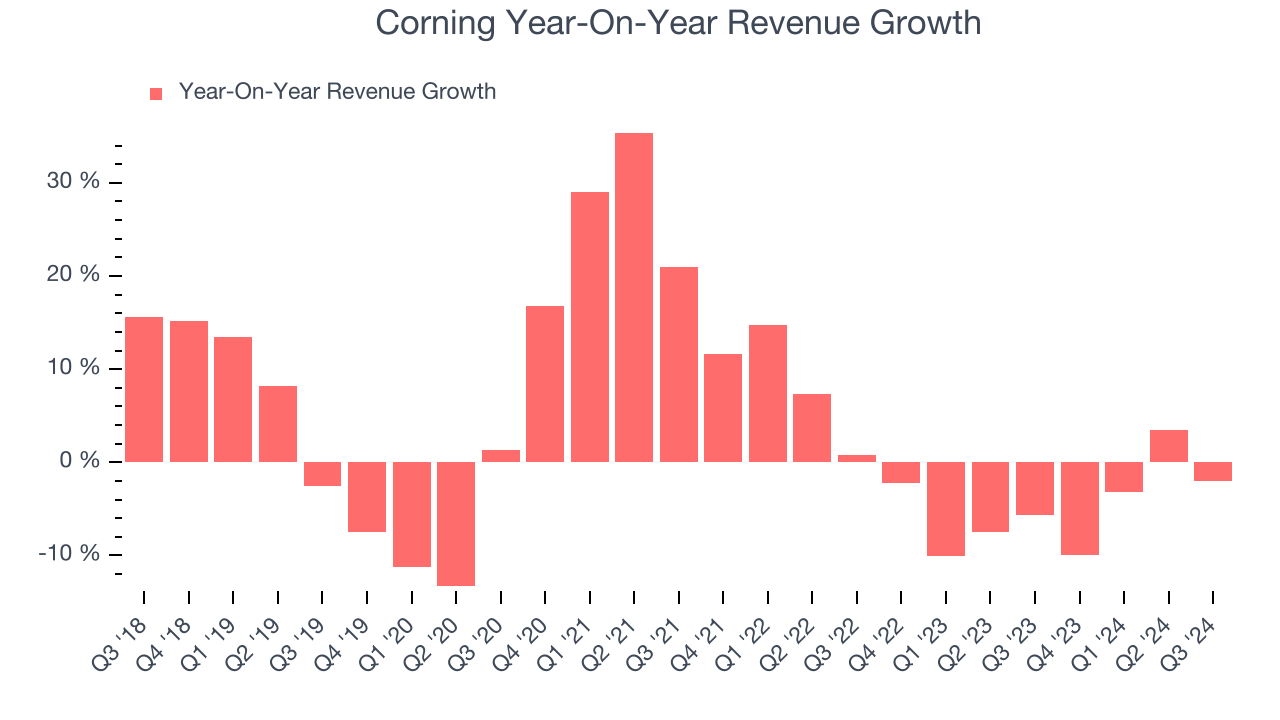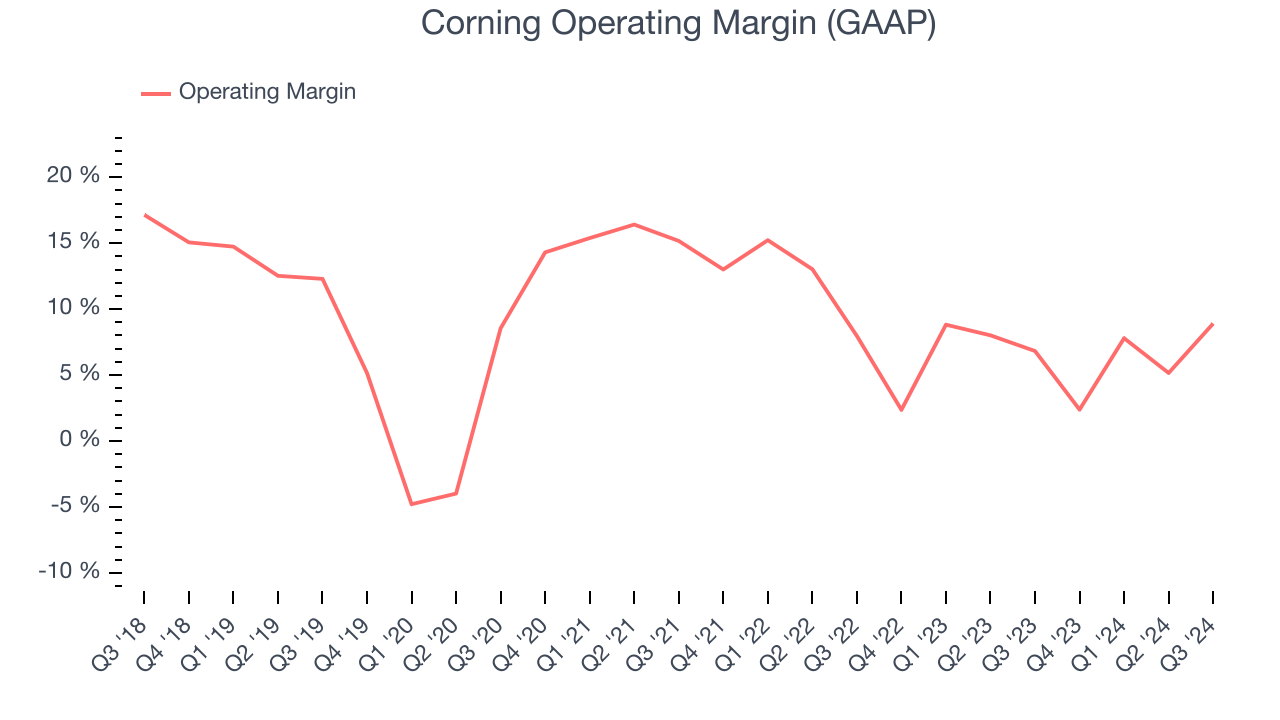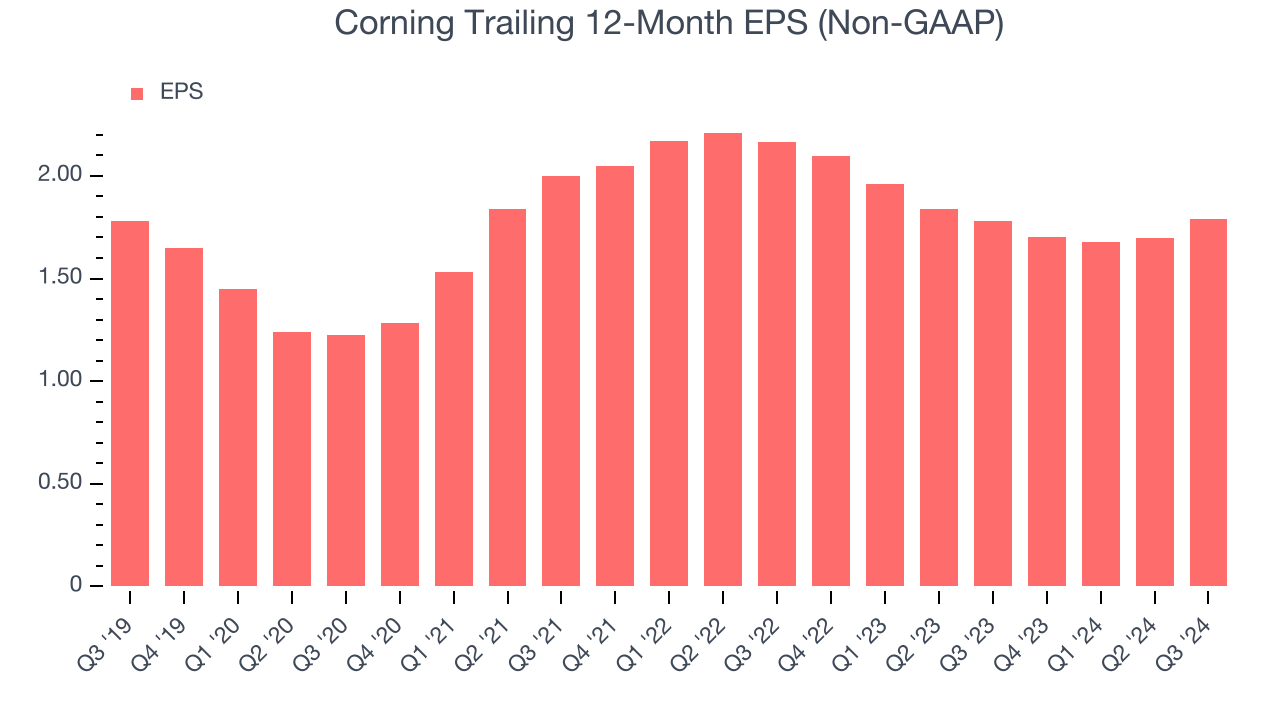
Glass and electronic component manufacturer Corning (NYSE:GLW) missed Wall Street’s revenue expectations in Q3 CY2024, with sales falling 2% year on year to $3.39 billion. On the other hand, next quarter’s outlook exceeded expectations with revenue guided to $3.75 billion at the midpoint, or 2.7% above analysts’ estimates. Its non-GAAP profit of $0.54 per share was 3.1% above analysts’ consensus estimates.
Is now the time to buy Corning? Find out by accessing our full research report, it’s free.
Corning (GLW) Q3 CY2024 Highlights:
- Revenue: $3.39 billion vs analyst estimates of $3.72 billion (8.9% miss)
- Adjusted EPS: $0.54 vs analyst estimates of $0.52 (3.1% beat)
- Revenue Guidance for Q4 CY2024 is $3.75 billion at the midpoint, above analyst estimates of $3.65 billion
- Adjusted EPS guidance for Q4 CY2024 is $0.55 at the midpoint, above analyst estimates of $0.52
- Gross Margin (GAAP): 33.5%, down from 37.3% in the same quarter last year
- Operating Margin: 8.9%, up from 6.8% in the same quarter last year
- Free Cash Flow Margin: 14.2%, similar to the same quarter last year
- Market Capitalization: $40.08 billion
Company Overview
Supplying windows for some of the United States’s earliest spacecraft, Corning (NYSE:GLW) provides glass and other electronic components for the consumer electronics, telecommunications, automotive, and healthcare industries.
Electronic Components
Like many equipment and component manufacturers, electronic components companies are buoyed by secular trends such as connectivity and industrial automation. More specific pockets of strong demand include data centers and telecommunications, which can benefit companies whose optical and transceiver offerings fit those markets. But like the broader industrials sector, these companies are also at the whim of economic cycles. Consumer spending, for example, can greatly impact these companies’ volumes.
Sales Growth
A company’s long-term performance can indicate its business quality. Any business can put up a good quarter or two, but many enduring ones grow for years. Unfortunately, Corning’s 2.6% annualized revenue growth over the last five years was sluggish. This shows it failed to expand in any major way, a rough starting point for our analysis.

Long-term growth is the most important, but within industrials, a half-decade historical view may miss new industry trends or demand cycles. Corning’s history shows it grew in the past but relinquished its gains over the last two years, as its revenue fell by 4.7% annually. Corning isn’t alone in its struggles as the Electronic Components industry experienced a cyclical downturn, with many similar businesses seeing lower sales at this time. 
We can better understand the company’s revenue dynamics by analyzing its most important segments, Optical Communications and Display Technologies, which are 36.7% and 29.9% of revenue. Over the last two years, Corning’s Optical Communications revenue (optical fiber & cables) averaged 7.2% year-on-year declines. On the other hand, its Display Technologies revenue (glass for flat panel displays) averaged 6.1% growth.
This quarter, Corning missed Wall Street’s estimates and reported a rather uninspiring 2% year-on-year revenue decline, generating $3.39 billion of revenue. Management is currently guiding for a 14.6% year-on-year increase next quarter.
Looking further ahead, sell-side analysts expect revenue to grow 10.6% over the next 12 months, an improvement versus the last two years. This projection is noteworthy and indicates the market thinks its newer products and services will spur faster growth.
Here at StockStory, we certainly understand the potential of thematic investing. Diverse winners from Microsoft (MSFT) to Alphabet (GOOG), Coca-Cola (KO) to Monster Beverage (MNST) could all have been identified as promising growth stories with a megatrend driving the growth. So, in that spirit, we’ve identified a relatively under-the-radar profitable growth stock benefitting from the rise of AI, available to you FREE via this link.
Operating Margin
Operating margin is a key measure of profitability. Think of it as net income–the bottom line–excluding the impact of taxes and interest on debt, which are less connected to business fundamentals.
Corning has done a decent job managing its cost base over the last five years. The company produced an average operating margin of 8.7%, higher than the broader industrials sector.
Looking at the trend in its profitability, Corning’s annual operating margin rose by 4.4 percentage points over the last five years, showing its efficiency has improved.

This quarter, Corning generated an operating profit margin of 8.9%, up 2.1 percentage points year on year. The increase was encouraging, and since its revenue and gross margin actually decreased, we can assume it was recently more efficient because it trimmed its operating expenses like marketing, R&D, and administrative overhead.
Earnings Per Share
Analyzing revenue trends tells us about a company’s historical growth, but the long-term change in its earnings per share (EPS) points to the profitability of that growth – for example, a company could inflate its sales through excessive spending on advertising and promotions.
Corning’s flat EPS over the last five years was below its 2.6% annualized revenue growth. However, its operating margin actually expanded during this timeframe, telling us that non-fundamental factors affected its ultimate earnings.

Like with revenue, we analyze EPS over a shorter period to see if we are missing a change in the business. For Corning, its two-year annual EPS declines of 9.1% show its recent history was to blame for its underperformance over the last five years. These results were bad no matter how you slice the data.
In Q3, Corning reported EPS at $0.54, up from $0.45 in the same quarter last year. This print beat analysts’ estimates by 3.1%. Over the next 12 months, Wall Street expects Corning’s full-year EPS of $1.79 to grow by 21.6%.
Key Takeaways from Corning’s Q3 Results
It was good to see Corning beat analysts’ EPS expectations this quarter. We were also glad next quarter’s revenue and EPS guidance exceeded Wall Street’s estimates. On the other hand, its revenue unfortunately missed. Overall, this quarter had some key positives. The stock traded up 7.9% to $50.56 immediately following the results.
So should you invest in Corning right now?The latest quarter does matter, but not nearly as much as longer-term fundamentals and valuation, when deciding if the stock is a buy. We cover that in our actionable full research report which you can read here, it’s free.













